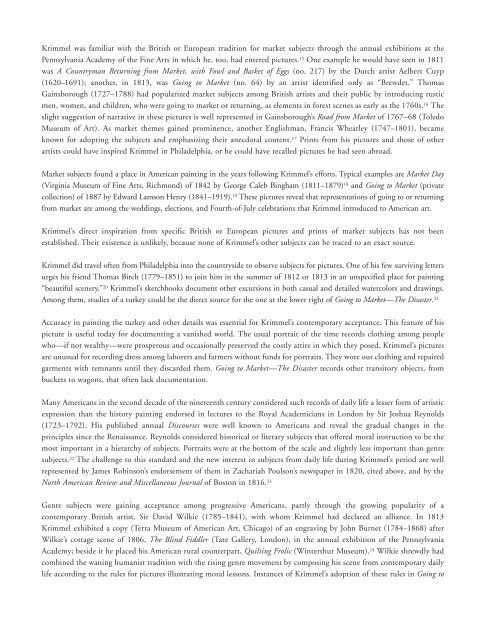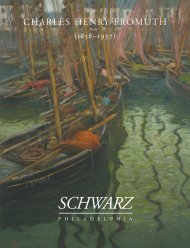pdf - Schwarz Gallery
pdf - Schwarz Gallery
pdf - Schwarz Gallery
Create successful ePaper yourself
Turn your PDF publications into a flip-book with our unique Google optimized e-Paper software.
Krimmel was familiar with the British or European tradition for market subjects through the annual exhibitions at the<br />
Pennsylvania Academy of the Fine Arts in which he, too, had entered pictures. 15 One example he would have seen in 1811<br />
was A Countryman Returning from Market, with Fowl and Basket of Eggs (no. 217) by the Dutch artist Aelbert Cuyp<br />
(1620–1691); another, in 1813, was Going to Market (no. 64) by an artist identified only as “Brewdet.” Thomas<br />
Gainsborough (1727–1788) had popularized market subjects among British artists and their public by introducing rustic<br />
men, women, and children, who were going to market or returning, as elements in forest scenes as early as the 1760s. 16 The<br />
slight suggestion of narrative in these pictures is well represented in Gainsborough’s Road from Market of 1767–68 (Toledo<br />
Museum of Art). As market themes gained prominence, another Englishman, Francis Wheatley (1747–1801), became<br />
known for adopting the subjects and emphasizing their anecdotal content. 17 Prints from his pictures and those of other<br />
artists could have inspired Krimmel in Philadelphia, or he could have recalled pictures he had seen abroad.<br />
Market subjects found a place in American painting in the years following Krimmel’s efforts. Typical examples are Market Day<br />
(Virginia Museum of Fine Arts, Richmond) of 1842 by George Caleb Bingham (1811–1879) 18 and Going to Market (private<br />
collection) of 1887 by Edward Lamson Henry (1841–1919). 19 These pictures reveal that representations of going to or returning<br />
from market are among the weddings, elections, and Fourth-of-July celebrations that Krimmel introduced to American art.<br />
Krimmel’s direct inspiration from specific British or European pictures and prints of market subjects has not been<br />
established. Their existence is unlikely, because none of Krimmel’s other subjects can be traced to an exact source.<br />
Krimmel did travel often from Philadelphia into the countryside to observe subjects for pictures. One of his few surviving letters<br />
urges his friend Thomas Birch (1779–1851) to join him in the summer of 1812 or 1813 in an unspecified place for painting<br />
“beautiful scenery.” 20 Krimmel’s sketchbooks document other excursions in both casual and detailed watercolors and drawings.<br />
Among them, studies of a turkey could be the direct source for the one at the lower right of Going to Market—The Disaster. 21<br />
Accuracy in painting the turkey and other details was essential for Krimmel’s contemporary acceptance. This feature of his<br />
picture is useful today for documenting a vanished world. The usual portrait of the time records clothing among people<br />
who—if not wealthy—were prosperous and occasionally preserved the costly attire in which they posed. Krimmel’s pictures<br />
are unusual for recording dress among laborers and farmers without funds for portraits. They wore out clothing and repaired<br />
garments with remnants until they discarded them. Going to Market—The Disaster records other transitory objects, from<br />
buckets to wagons, that often lack documentation.<br />
Many Americans in the second decade of the nineteenth century considered such records of daily life a lesser form of artistic<br />
expression than the history painting endorsed in lectures to the Royal Academicians in London by Sir Joshua Reynolds<br />
(1723–1792). His published annual Discourses were well known to Americans and reveal the gradual changes in the<br />
principles since the Renaissance. Reynolds considered historical or literary subjects that offered moral instruction to be the<br />
most important in a hierarchy of subjects. Portraits were at the bottom of the scale and slightly less important than genre<br />
subjects. 22 The challenge to this standard and the new interest in subjects from daily life during Krimmel’s period are well<br />
represented by James Robinson’s endorsement of them in Zachariah Poulson’s newspaper in 1820, cited above, and by the<br />
North American Review and Miscellaneous Journal of Boston in 1816. 23<br />
Genre subjects were gaining acceptance among progressive Americans, partly through the growing popularity of a<br />
contemporary British artist, Sir David Wilkie (1785–1841), with whom Krimmel had declared an alliance. In 1813<br />
Krimmel exhibited a copy (Terra Museum of American Art, Chicago) of an engraving by John Burnet (1784–1868) after<br />
Wilkie’s cottage scene of 1806, The Blind Fiddler (Tate <strong>Gallery</strong>, London), in the annual exhibition of the Pennsylvania<br />
Academy; beside it he placed his American rural counterpart, Quilting Frolic (Winterthur Museum). 24 Wilkie shrewdly had<br />
combined the waning humanist tradition with the rising genre movement by composing his scene from contemporary daily<br />
life according to the rules for pictures illustrating moral lessons. Instances of Krimmel’s adoption of these rules in Going to



